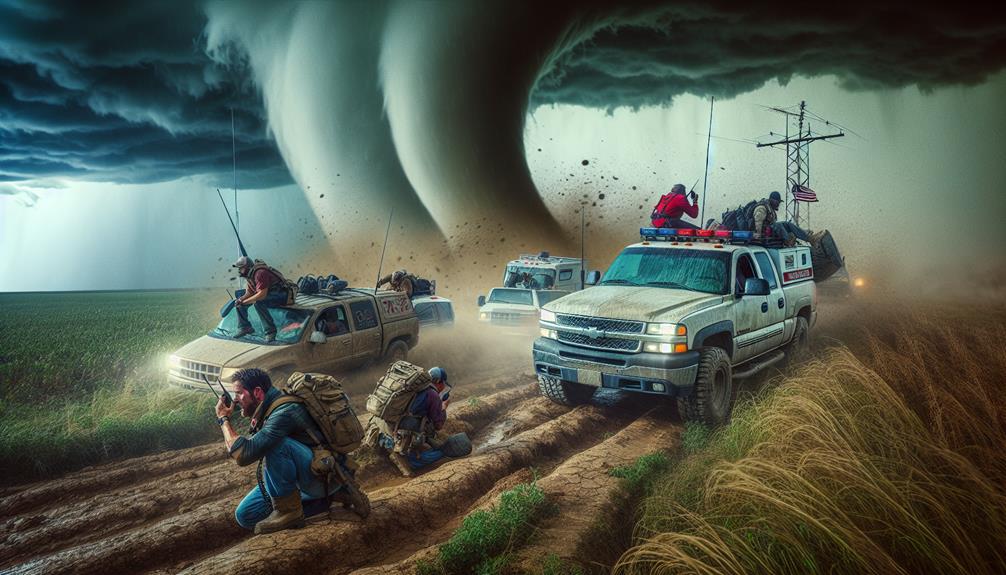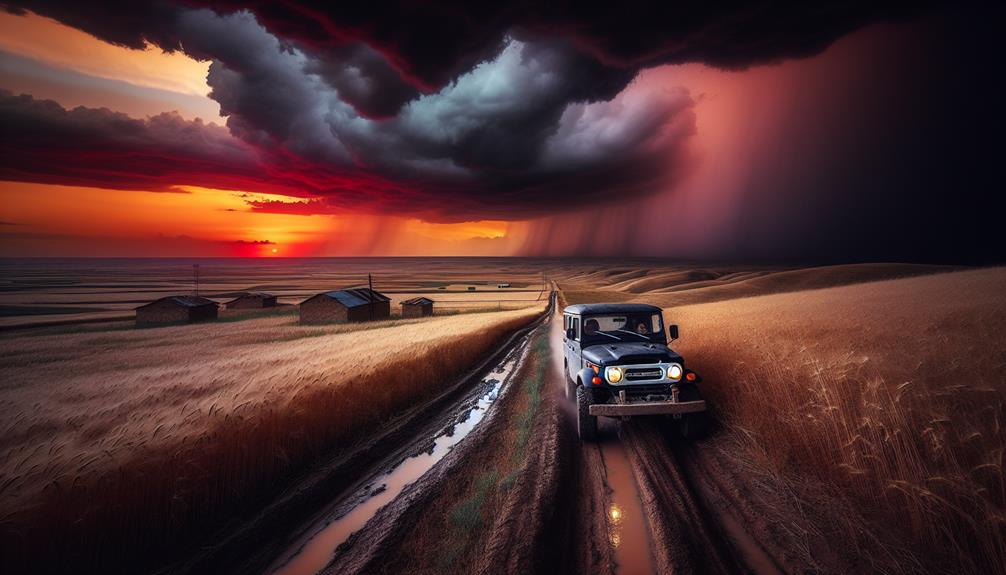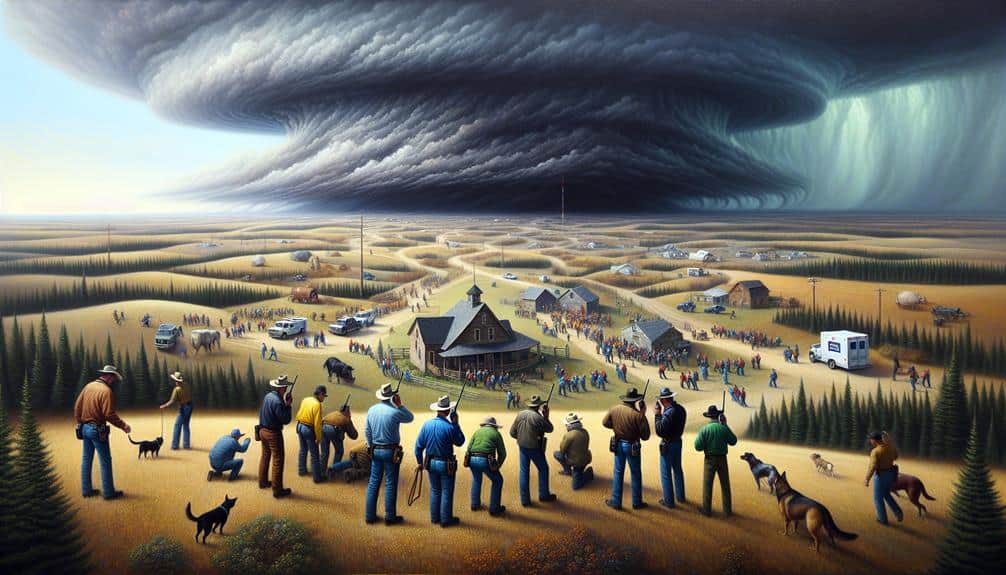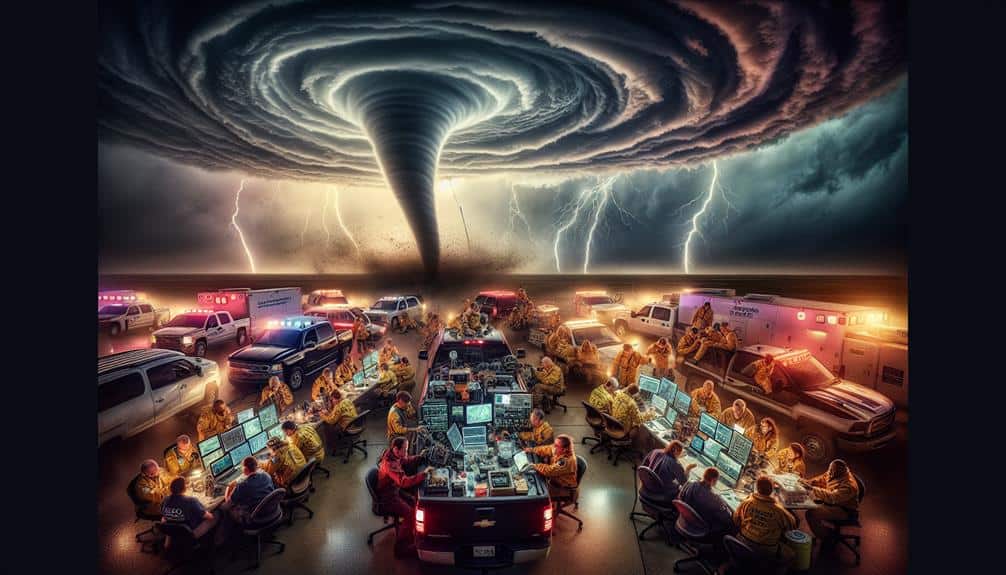As rural storm chasers, we grapple with coordination challenges due to limited communication networks, inadequate road infrastructure, and scarce specialized resources. Reliable real-time data sharing is compromised by poor signal strength, impacting GPS tracking and decision-making. Sparse sensor networks and insufficient Doppler radar coverage hinder accurate weather forecasting. Geographic isolation further complicates team coordination and emergency responses. Funding constraints limit the deployment of advanced technologies and essential equipment, affecting our operational readiness and safety. Properly allocated budgets and innovative solutions are vital for enhancing our effectiveness in these remote areas. To learn more, understanding these dynamics in detail is necessary.
Key Points
- Sparse communication networks hinder real-time data sharing and coordination.
- Limited internet and cell tower infrastructure disrupts reliable remote communication.
- Inadequate road access impacts mobility and response times.
- Weak signal strength hampers GPS tracking and data transmission.
Communication Barriers
One significant challenge we face as rural storm chasers is the limited availability of reliable communication networks. When we're out in the field, remote communication becomes a vital component of our operations. Nevertheless, rural technology often lags behind urban regions, leading to inconsistent and weak signals. This lack of connectivity hampers our ability to share real-time data, coordinate movements, and receive timely weather updates.
For instance, during a recent storm chase, our team experienced a 40% drop in signal strength, disrupting our GPS tracking and data transmission. This makes it difficult to relay essential information about the storm's path to both our team members and emergency responders. Additionally, the limited bandwidth in these areas can cause significant delays in data uploads, impacting our overall efficiency.
To mitigate these challenges, we've started employing satellite phones and portable signal boosters. These tools enhance our remote communication capabilities, but they come with their own set of limitations, such as high costs and maintenance requirements.
Despite these hurdles, leveraging advanced rural technology is crucial for improving our coordination and ensuring our safety during storm chases. We must continue to innovate and adapt to overcome these communication barriers.
Limited Infrastructure
When operating in rural areas, we often encounter sparse communication networks that hinder real-time data sharing and coordination.
Additionally, inadequate road access often limits our mobility and response times.
These infrastructure challenges greatly impact the efficiency and safety of our storm-chasing efforts.
Sparse Communication Networks
Despite advancements in meteorological technology, rural storm chasers frequently encounter significant coordination issues due to sparse communication networks and limited infrastructure.
One of the primary challenges we face is maintaining reliable remote monitoring. Our ability to track storm developments in real time is often compromised by weak signal strength. This is particularly problematic in isolated areas where cellular towers are few and far between.
When signal strength fluctuates, our data transmission capabilities suffer, leading to delays in weather updates and risk assessments. This latency can jeopardize our safety and the accuracy of our reports. Additionally, the limited infrastructure means that we can't always depend on consistent internet access for uploading critical data to centralized databases.
We rely on robust communication networks to coordinate with other storm chasers and emergency services. However, the sparse network coverage in rural areas restricts our ability to share real-time information, increasing the difficulty of making informed decisions.
This lack of connectivity not only hampers our operational efficiency but also diminishes our capacity to contribute to broader meteorological research efforts.
Inadequate Road Access
Inadequate road access in rural areas significantly impedes our ability to reach key observation points and respond promptly to emerging storm threats. The rural infrastructure often consists of unpaved, narrow roads that can become impassable during severe weather events. This limited infrastructure notably increases our navigation difficulties, reducing our operational efficiency and jeopardizing safety.
For instance, limited visibility during heavy rainfall or low-light conditions worsens the challenge of maneuvering through these poorly maintained roads. According to data from the National Weather Service, approximately 60% of rural roads are considered 'below standard,' directly impacting our mobility and route planning. These conditions force us to take longer, less direct routes, increasing our response time and reducing our ability to collect timely data.
Moreover, GPS inaccuracies in remote areas further complicate navigation, leading to potential delays and missed observation opportunities. A study by the American Meteorological Society highlighted that rural chasers experience a 25% higher incidence of navigation errors compared to their urban counterparts.
These road access issues not only hinder our immediate objectives but also compromise the overall effectiveness of storm tracking and public safety measures. To maximize our operational freedom, addressing these infrastructural deficiencies is essential.
Resource Allocation

Efficient resource allocation is crucial for maximizing the operations of rural storm chasers. Our primary challenge lies in the precise funding allocation necessary to uphold and improve our capabilities. Limited budgets require us to prioritize between critical needs such as advanced radar systems, reliable communication devices, and all-terrain vehicles. Balancing these needs guarantees we're prepared for unpredictable weather patterns.
Equipment availability is another key factor in resource allocation. We must strategically invest in high-quality, durable gear that can withstand extreme conditions. For example, mobile Doppler radar units and high-definition cameras are essential for real-time data collection and analysis. However, the scarcity of such specialized equipment in rural areas can impede our readiness and response times.
Additionally, we must account for the logistics of deploying resources efficiently across vast, often remote areas. This includes not only the physical distribution of equipment but also the coordination of personnel. Ensuring that each team member is equipped and positioned optimally requires careful planning and constant communication.
Weather Forecasting Issues
We face significant challenges with limited data accuracy and forecasting equipment constraints in rural areas. Inaccurate data inputs lead to unreliable storm predictions, impacting our ability to prepare effectively.
Additionally, outdated or insufficient forecasting tools further exacerbate these issues, limiting our response capabilities.
Limited Data Accuracy
Accurate weather forecasting is often compromised in rural areas due to sparse meteorological data collection points. This limitation poses noteworthy coordination challenges for storm chasers who rely on precise data to predict severe weather events.
When we're out in the field, the reliability of our equipment and the precision of data interpretation become critical factors.
Equipment Reliability: In rural settings, the fewer data collection points we have, the more strain there's on each piece of equipment. If one station goes down, the data gap can significantly affect the forecast's accuracy.
Data Interpretation: Sparse data can lead to substantial errors in interpreting weather patterns. With fewer data points, the models have to interpolate more, which increases the margin of error and reduces our ability to make accurate predictions.
Temporal Gaps: Rural areas often have longer intervals between data updates, making it difficult for us to track rapidly changing weather conditions in real-time. These temporal gaps can lead to outdated forecasts and delayed reactions to evolving storm systems.
Forecasting Equipment Constraints
Forecasting equipment in rural areas often suffers from limitations that impede our ability to gather high-resolution data vital for accurate storm prediction. We face significant challenges due to outdated radar systems and sparse sensor networks, which restrict our capacity for remote monitoring. High-quality data is essential for precise storm tracking, but rural regions frequently lack the technological infrastructure to support advanced meteorological equipment.
One major constraint is the limited deployment of Doppler radar systems, which are essential for detecting wind patterns and storm formations. In urban areas, dense sensor networks provide detailed data, but rural regions often rely on fewer, widely spaced sensors. This gap in data collection can lead to inaccuracies and delays in storm predictions, compromising our ability to make timely decisions.
Additionally, while technology advancements have improved forecasting models, these improvements aren't always accessible in rural settings. For instance, mobile weather stations and drones equipped with cutting-edge sensors could enhance our remote monitoring capabilities. However, the cost and logistical challenges of deploying these technologies in remote areas often hinder their widespread adoption.
To overcome these constraints, we need to advocate for better funding and increased investment in rural meteorological infrastructure. By enhancing our data collection capabilities, we can improve the accuracy and timeliness of storm predictions, ultimately safeguarding lives and property in these vulnerable areas.
Geographic Isolation

Geographic isolation greatly hinders rural storm chasers by limiting access to real-time meteorological data and essential communication networks. When we're out in the field, several substantial challenges emerge that affect our efficiency and safety.
- Remote Monitoring: In rural areas, the lack of robust internet and cell tower infrastructure severely compromises our ability to receive timely updates from weather stations and satellites. Without this data, our capacity to accurately track storm movements and predict their paths is reduced.
- Team Logistics: Coordinating multiple teams becomes problematic in isolated regions. The sparse population density means fewer roads and longer distances between key points, complicating the logistics of deploying and regrouping our teams. We often find ourselves relying on less reliable communication methods, increasing the risk of miscoordination.
- Limited Shelter Options: Given the geographic isolation, accessible safe zones are few and far between. When storms intensify, our options for seeking immediate shelter are limited, posing a substantial risk to our safety and operational continuity.
Addressing these challenges requires innovative solutions and adaptive strategies. Improving remote monitoring capabilities and optimizing team logistics can significantly enhance our effectiveness in rural environments, allowing us to pursue our passion for storm chasing with greater freedom and security.
Emergency Services Coordination
Coordinating with emergency services in rural areas is crucial, as it secures timely responses and resource allocation during severe weather events. When a storm hits, swift response time can mean the distinction between life and death. We must make sure our collaboration with local emergency services is seamless. This necessitates clear communication channels and pre-established protocols.
Resource sharing is another vital aspect. Rural areas often face resource constraints that urban centers don't. By pooling our resources—whether it's equipment, personnel, or real-time data—we can enhance the overall response effectiveness. Our joint efforts can markedly reduce redundancy and make certain that critical resources are available where they're needed most.
Training is also paramount. Both storm chasers and emergency services need to undergo specialized training to handle severe weather conditions effectively. This includes understanding each other's roles, practicing coordinated drills, and sharing knowledge about local terrain and potential hazards. By investing in thorough training programs, we not only improve our own preparedness but also foster a culture of mutual support and efficiency.
Community Preparedness

Effective community preparedness hinges on our ability to educate local residents about severe weather protocols and guarantee they've access to necessary resources and information. To enhance our disaster response, we must foster community engagement through systematic approaches.
We've identified three key strategies:
- Education Programs: Implementing workshops and seminars focused on severe weather recognition, emergency communication channels, and evacuation procedures. Data from the National Weather Service shows that communities with robust educational initiatives experience a 30% increase in timely evacuations.
- Resource Allocation: Ensuring that emergency kits, weather radios, and first aid supplies are readily available. By distributing these resources, we empower individuals to act swiftly during a disaster, reducing dependence on external aid.
- Communication Networks: Establishing reliable, redundant communication systems such as text alerts, social media updates, and community bulletin boards. According to FEMA, communities with diversified communication channels report a 40% improvement in coordinated disaster responses.
Our focus on community engagement not only boosts preparedness but also cultivates a culture of resilience. With precise education, resource distribution, and robust communication networks, we can significantly enhance our collective disaster response capabilities.
Let's prioritize these strategies to safeguard our rural communities.
Frequently Asked Questions
How Do Storm Chasers Handle Personal Safety in Remote Rural Areas?
We secure our personal safety in remote rural areas through meticulous personal preparation and emergency response protocols, including GPS tracking, backup communication devices, and real-time weather data access. These measures maximize our freedom to chase storms safely.
What Training Is Required to Become a Rural Storm Chaser?
To become rural storm chasers, we undergo extensive training in field research and safety protocols. For instance, we might study case studies on tornado behavior, ensuring we're prepared for data collection while prioritizing our safety in unpredictable environments.
How Do Storm Chasers Document Their Findings in Rural Environments?
We document our findings in rural settings through precise data collection and advanced technology. Field observations are meticulously recorded, then communicated via satellite and mobile networks, ensuring real-time updates and thorough analysis for accurate storm tracking.
What Legal Permissions Are Needed for Storm Chasing in Rural Regions?
We need to navigate permit requirements and land access restrictions. Local authorities may impose specific regulations, so we must secure necessary permissions to guarantee compliance. Freedom to chase comes with following the legal framework in rural regions.
How Do Rural Storm Chasers Maintain Their Equipment in Harsh Conditions?
We are aware that an ounce of prevention is worth a pound of cure. We perform regular equipment maintenance and carry spare parts to guarantee functionality in remote locations, despite harsh conditions, securing our freedom to chase storms effectively.


